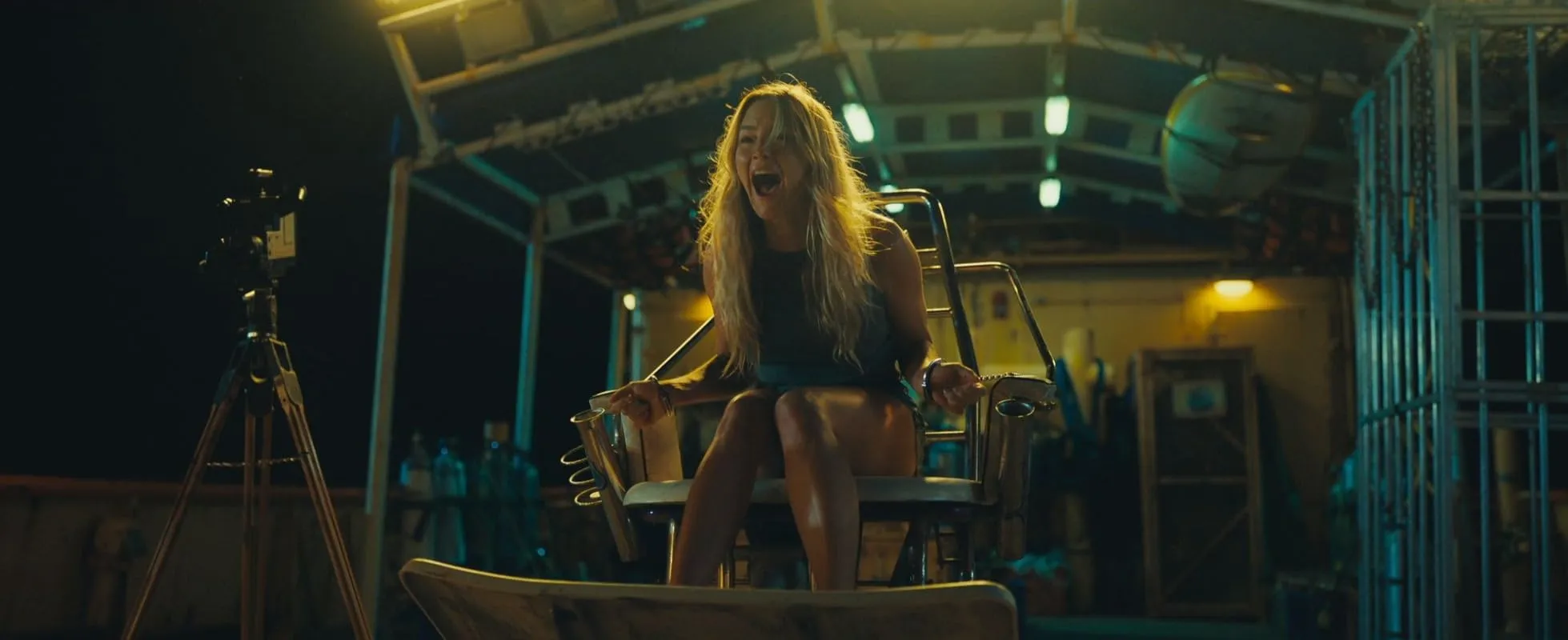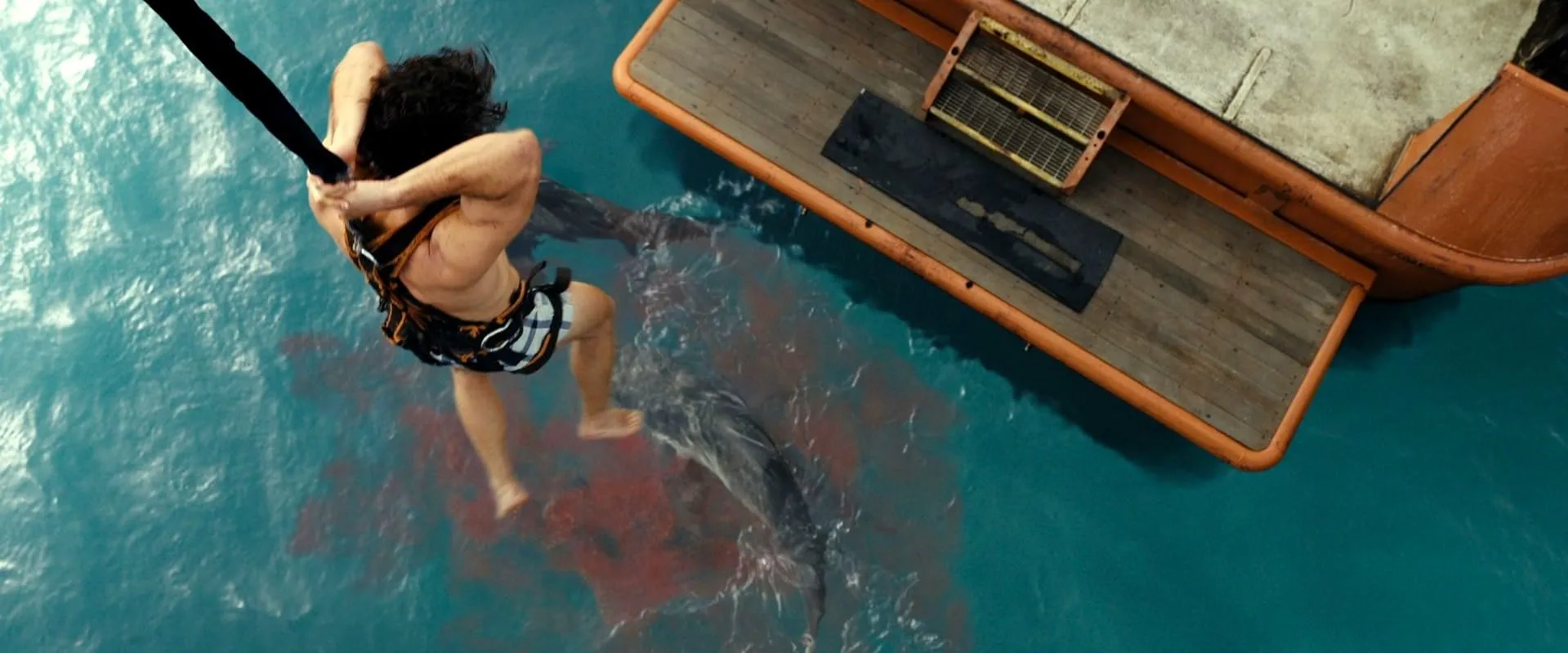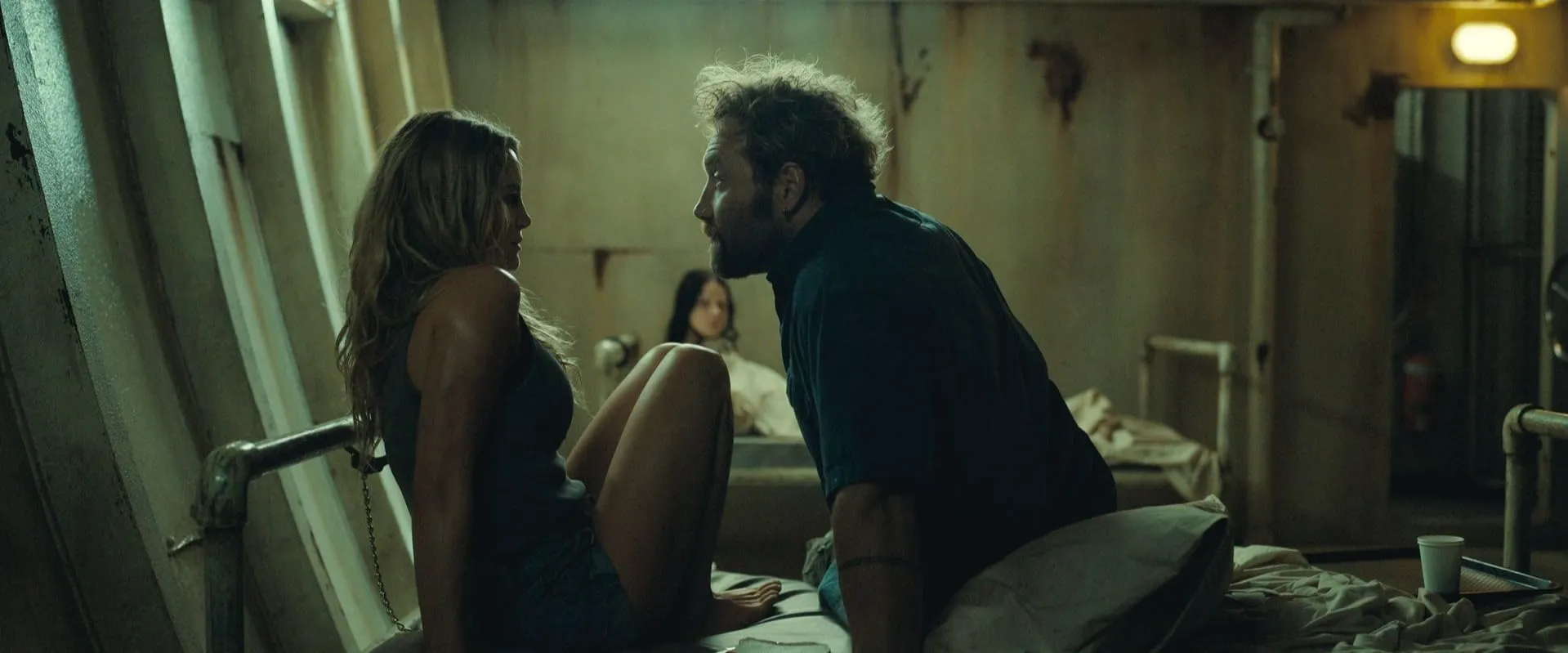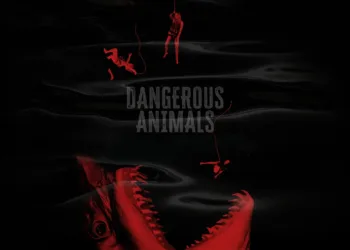A seemingly innocuous shark-tour spirals into something far darker when Tucker, a gregarious Aussie skipper, reveals his true vocation: luring women into the jaws of great whites for his personal snuff‐film library. (Think “nature cinema” meets “torture-porn,” and you’re only half there.)
Set against the sun-bleached Gold Coast—where turquoise beauty masks latent horror—Sean Byrne’s latest collaboration with writer Nick Lepard toggles between claustrophobic serial-killer suspense and splinter-furious creature feature. The rusting hull of Tucker’s boat becomes both stage and cell: an ironic microcosm of civilization’s thin veneer.
Byrne, whose résumé includes the brutal intimacy of The Loved Ones and the fevered aesthetic of Devil’s Candy, orchestrates this narrative with a clinical eye. Lepard’s screenplay (equal parts pop-psychology and shark-mythos) imbues Tucker’s pathology with just enough oblique backstory—a childhood brush with a finned titan—to spur endless debate on whether he worships or envies his piscine counterparts.
What distinguishes Dangerous Animals in the overcrowded shark-horror lagoon is its sly invitation to ponder predator and prey as interchangeable roles. (Cue the term “thalassophobia noir.”) Will audiences recoil at the cruelty, or recognize in Tucker’s ritual a distorted mirror of our own voyeuristic impulses? Either way, the film promises more than mere jump scares—it holds up a dark lens to our primal fears.
Charting the Predator’s Course
The film plunges in with a deceptively jaunty shark-tour sequence: sunlit waters, carefree tourists, and Tucker’s breezy pitch (he even croons “Baby Shark,” of all things). Within minutes, the mood curdles—our guide becomes the architect of terror, rigging his cage-dive as a death sentence. This cold open does more than shock; it posts a warning about voyeurism’s dark underbelly (a digital-age echo of early cinema’s fascination with on-screen violence).
From that first kill, the narrative stakes crystallize: women become bait, and Tucker’s rusting vessel a floating amphitheater of brutality. We meet Zephyr offscreen—her fate sealed by a flirtation with Moses—before the screen carves her story into view. The gradual reveal of her abduction mimics a historical lament: settlers entrapped by promises of paradise (Gold Coast idyll versus maritime gulag).
Once aboard, the ship transforms into a claustrophobic chessboard. Zephyr’s escape attempts—sly twists through narrow corridors, half-lit cabins—echo fugitive plots of wartime bunkers or clandestine Cold War hideouts. Each time she almost breaks free, Tucker snatches her back with mechanical precision, as though executing a grim ritual of power. These ebb-and-flow sequences oscillate between adrenalin rush and moral unease, prompting reflection on systemic entrapment (think phantom cages of social media, where every move is surveilled).
In the finale, the duel cements the film’s thesis: predator and prey blur. Eye-to-eye confrontations atop the boat’s deck recall gladiatorial combats—ancient rites repurposed for modern horror. Here, Byrne accelerates the editing until breaths are ragged, then abruptly cuts to silence, compounding shock with introspection.
When the credits loom, we’re left questioning who truly prowls the depths: the shark, the psychopath, or the camera itself, hungry for suffering. It’s an unsettling twist on familiar genre mechanics—one that might just recalibrate how we view our own complicity in sensationalized violence.
Faces of the Abyss
Bruce “Tucker” is less a man than an apex predator in human guise. Jai Courtney bulks up, lumbering with the gait of a bear (if that bear wore a captain’s hat and a maniacal grin). His whispered monologues about shark hierarchies recall the fevered declarations of 19th-century showmen hawking exotic beasts—only here the exhibit is live flesh.
Beneath the rugged beard and boozy charm, you sense a trauma-scarred soul: a childhood brush with a great white that cemented his identification with the toothy hunters of the deep. In this “chum-cinema,” Tucker exchanges genuine empathy for animals (or so he claims) in favor of orchestrating human sacrifice. It’s a performance that probes our own dark fascination with nature’s cruelty.
Zephyr emerges not as a damsel, but as a salt-water survivor. Hassie Harrison embodies that “foster-home feral,” a loner shaped by rejection and waves rather than playgrounds. Her backstory (shuffled from one temporary home to the next) renders every narrow escape aboard Tucker’s vessel an act of defiance against the systems that once confined her. She improvises—using a hairpin to pick locks or a broken surfboard edge as a makeshift chisel—illustrating resourcefulness born of adversity. In her, the film taps into the archetype of the cast-off hero, reminiscent of wartime refugees forging new identities under fire.
Moses, the earnest realtor-turned-rescuer, offers a soft counterpoint to the brutality at sea. His love story provides respite—brief, yes, but vital: a reminder that human connection can still bloom amid carnage. And Heather (plus the couple at the start) serves as stand-ins for every unsuspecting traveler lured by paradise’s promise, only to find themselves on the menu.
Together, the ensemble strikes a jarring balance. Courtney’s raw menace and Harrison’s taut resilience generate electric tension, though at times the script’s uneven depths leave them floundering. Still, their chemistry—equal parts antagonism and unspoken kinship—elevates what could have been a rote showdown into a psychological duel with ripples far beyond the screen.
Stylistic Undertow
Byrne navigates the film’s dual identity—part creature feature, part serial-killer tableau—with the precision of a tightrope walker over a feeding frenzy. He leans into jump scares (a sudden shark fin slicing the frame), yet he also savors prolonged stares at Tucker’s empty gaze, cultivating a sustained dread that seeps into the viewer’s subconscious. (It’s what you might call “anticipation horror”—the terror of knowing what’s coming but unable to stop it.)
The production design turns Tucker’s boat into a “floating cell” (an aquatic panopticon where every scratch on the wall is a tally mark of past victims). Tight corridors and claustrophobic cabins evoke the submarine thrillers of Cold War cinema, in which isolation itself becomes the antagonist. Meanwhile, the omnipresent VHS tapes and the grisly keepsakes of victims’ hair are not mere set dressing but artifacts of Tucker’s psyche—he documents his atrocities as if curating a macabre museum, a perverse analogue to social-media exhibitionism.
Editing and pacing function like tidal forces. Quick cuts during shark sequences mimic the fragmented perspective of prey, disoriented and fighting for survival. Byrne cross-cuts between Moses’s terrestrial search and Zephyr’s oceanic nightmare, forging a contrapuntal rhythm that underscores the gulf between safety and peril. In doing so, the film mirrors modern surveillance culture—where one shot of someone’s distress can go viral even as help remains out of reach.
The cinematography contrasts sun-drenched exteriors—idealized postcard visions of the Gold Coast—with dim, oppressive interiors below deck. Wide, gorgeous aerial shots recall the tourist brochures that lure travelers, only to subvert that promise of paradise. When sharks breach the surface, Byrne blends real-footage glimpses with CG enhancements so seamlessly you momentarily forget which is which—much like the way fake news blends into genuine headlines.
Michael Yezerski’s score (augmented by David White’s sound design) oscillates between minimalist rumblings and full-throttle orchestral assaults. Diegetic elements—a gleeful “Baby Shark” rendition or a riff on classic Oz-rock—puncture the tension with ironic levity, reminding us that horror often dances hand-in-hand with the absurd.
Practical effects anchor the gore in tangible brutality: blood spatters on steel floors, flesh torn with bone-crunching sound. Underwater attack visuals, though occasionally CGI-reliant, are staged with enough realism to elicit genuine flinches. In these moments, the film achieves what one might dub “immersive terror”—a sensation of being both hunter and hunted, wading in waters that refuse to distinguish between human and animal threat.
Beneath the Surface Currents
Tucker’s sadistic ritual casts him as both ringmaster and shark, blurring the line between human predator and animal instinct. His feigned reverence for great whites rings hollow—an exploitative echo of colonial-era hunters who preached stewardship while cleaving through native ecosystems. (Now that’s what I call “eco-hypocrisy horror.”) In Tucker’s world, the apex apexes us—every bite a grotesque reminder that power often wears a benevolent mask.
Isolation amplifies this dynamic. The open ocean, mythologized as boundless freedom, becomes an inescapable cell. Zephyr’s forced captivity evokes Cold War submarine tales where the hull’s metal walls are as suffocating as political ideology. Being watched—cameras rolling, sharks circling—triggers a panopticon effect, turning survival into performance art.
Obsession and trauma underpin both hunter and hunted. Tucker’s childhood brush with a great white is his origin myth, fueling a perverse identification with the animal kingdom’s most vilified member. Conversely, Zephyr’s foster-care past—and her devotion to the surf—forge resilience that no cage can contain. In some ways, her scars run deeper than his; trauma can be tidal, eroding the self one wave at a time.
So who’s really monstrous? Tucker, the shark, or our own collective appetite for blood-letting spectacle? The film doesn’t merely ask the question—it shoves the mirror in our face.
Closing the Cage Door
Dangerous Animals achieves visceral thrills and thematic bite in equal measure, even if its narrative gets occasionally tangled in genre chatter. Sean Byrne’s hybrid of shark terror and serial-killer sadism delivers jump-out-of-seat shocks and invites reflection on our complicit fascination with voyeuristic cruelty.
Late-night viewers craving gore will find a feast; horror aficionados seeking subtext will unearth questions about power, spectacle, and the primal fear of nature untamed. Though moments of repetition muddy the pacing, Jai Courtney’s feral charm and Hassie Harrison’s tenacious spirit ensure the film stakes its claim in shark cinema’s evolving depths. It’s a murky but compelling entry in the ever-expanding ocean of aquatic horror. Dangerous Animals premiered on May 17, 2025, at the Cannes Film Festival in the Directors’ Fortnight section.
Full Credits
Director: Sean Byrne
Writer: Nick Lepard
Producers: Troy Lum, Andrew Mason, Pete Shilaimon, Mickey Liddell, Chris Ferguson, Brian Kavanaugh-Jones
Executive Producers: Fred Berger, Mehrdod Heydari, Marlaina Mah, Jacob Yakob
Cast: Hassie Harrison, Jai Courtney, Josh Heuston, Ella Newton, Rob Carlton, Liam Greinke, James Munn, Jon Quested, Mike Goldman, Ryland Pearson-McManus, Teah Fraser, Sean Richard, Jess Tredinnick
Director of Photography (Cinematographer): Shelley Farthing-Dawe
Editor: Kasra Rassoulzadegan
Composer: Michael Yezerski
The Review
Dangerous Animals
Dangerous Animals is a grisly, thought-provoking mash-up that delivers both shark-infested suspense and chilling human depravity. Courtney’s snarling predator and Harrison’s resilient survivor spark an uneasy duel that probes our fascination with spectacle and fear. While its pacing sometimes stalls, Byrne’s audacious blend of subgenres and sharp thematic undercurrents make for a deeply unsettling ride. Verdict: a darkly intelligent horror outing that’ll haunt late-night viewers long after the credits roll.
PROS
- Compelling lead performances (Courtney’s menace, Harrison’s grit)
- Rich thematic undercurrents about voyeurism and nature
- Effective sound design and score that amplify tension
- Claustrophobic production design aboard the boat
- Satisfying blend of creature feature and serial-killer tropes
CONS
- Pacing lags in repetitive escape-attempt sequences
- Secondary characters remain underdeveloped
- Occasional reliance on CGI sharks
- Villain’s motivations feel thinly sketched
- Jump scares sometimes undermine sustained dread




















































